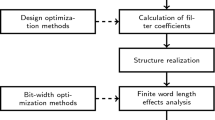Abstract
An extension of a polynomial consists of the polynomial plus higher power terms. Given a polynomial with real coefficients and an integer larger than its degree, a method is given that produces a finite list of extensions of degree this larger integer such that this list necessarily contains the extension whose largest root is as small as possible. This extension is called the pole radius minimizer. The pole radius minimizer is then found by the finite check of comparing the polynomials in the list. The method is applied to obtain filter transformations that are optimal as regards throughput, but also have considerable savings in hardware overhead compared with standard methods such as Scattered Lookahead and Minimum Order Augmentation. The table in Section 5 gives an explicit comparison for various kinds of filters.
Similar content being viewed by others
References
K.K. Parhi and D.G. Messerschmitt, “Pipeline Interleaving and Parallelism in Recursive Digital Filters,” IEEE Trans. Acoust. Speech and Signal Proc. vol. 37, 1989, pp. 1099–1117.
Y. Lim and B. Liu, “Pipelined Recursive Filter with Minimum Order Augmentation,” IEEE Trans. Signal Processing, vol. 40, 1992, pp. 1643–1651.
M. Sharma and N.R. Shanbhag, “Architecture Driven Filter Transformations,” Presented at the International Symposium on Circuits and Systems, Geneva, Switzerland, May, 2000.
N.G. Tschebotaröw, “Über die Fortsetzbarke-it von Polynomen auf geschlossene Kurven,” C.R. (Doklady) Acad. Sci. URSS (N.S.), vol. 32, 1941, pp. 3–6.
L. Gavrilov, “On K-Prolongeable Polynomials,” C.R. (Doklady) Acad. Sci. URSS (N.S.), vol. 37, 1942, pp. 246–249.
L. Gawrilov and N. Tschebotaröow, “Über F-Polynome. VI. K-Polynome Mit Verschobenem Zentrum,” Bull. Soc. Phys.-Math. Kazan (3), vol. 12, 1940, pp. 183–195.
N.G. Tschebotareff, “On Continuable Polynomials. I. General Statement of the Problem.” in Memorial volume dedicated to D.A.Grave [Sbornik posvjascenii pamjati D.A.Grave], Moscow: publisher unknown, 1940, pp. 268–282.
D. Henrion, D. Peaucelle, D. Arzelier, and M. Sebek, “Ellipsoidal Approximation of the Stability Domain of a Polynomial,” in Proceedings of the European Control Conference ECC, Porto, Portugal, 2001, pp. 384–389.
J. Ackermann, “Parameter Space Design of Robust Control Systems,” IEEE Trans. Automatic Control, vol. 25, no. 6, 1980, pp. 1058–1072.
M. Marden, The Geometry of the Zeros of a Polynomial in a Complex Variable, AMS Math Surveys, No. 3, New York, 1949, pp. 1–183.
Author information
Authors and Affiliations
Corresponding author
Additional information
Nigel Boston Undergraduate degree from Cambridge University, UK, followed by a mathematics Ph.D. from Harvard in 1987. After a year at IHES, France, and two years as a Morrey Assistant Professor at Berkeley, went to the University of Illinois at Urbana-Champaign. Was founding director of the Illinois Center for Cryptography and Information Protection in the Coordinated Science Lab at UIUC and organized the first three Midwest Arithmetical Geometry in Cryptography meetings. Left UIUC in 2002 to become a Full Professor at the University ofWisconsin, with a split appointment in mathematics and ECE and affiliate appointment in CS. Working on applications of algebra and number theory to engineering in areas such as cryptography, coding theory, watermarking, and biometrics.
Rights and permissions
About this article
Cite this article
Boston, N. Pipelined IIR Filter Architecture Using Pole-Radius Minimization. J VLSI Sign Process Syst Sign Image Video Technol 39, 323–331 (2005). https://doi.org/10.1007/s11265-005-4848-3
Received:
Revised:
Accepted:
Issue Date:
DOI: https://doi.org/10.1007/s11265-005-4848-3




